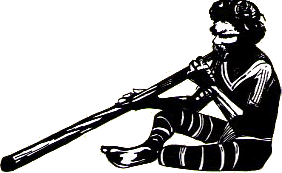Aboriginal people throughout most of Australia believe that in the
beginning of time, in the Dreaming, there were no visible landmarks;
the world was flat. As time progressed, creatures emerged from the
ground and had the power to change at will from their animal to their
human form.
The kangaroo ancestor may now be described, in songs particularly,
as the kangaroo; the form of his life essence is a matter of little
consequence. These original ancestral beings created all the features
of the landscape in the area in which their lives were spent, and
also populated the entire region concerned. By their actions they
laid down the rules of conduct for all their offspring.

Throughout their lives on earth they left inseminating powers in the
soil; they also created, and taught to others, many songs including
those recounting the history of their own lives, songs for healing
the wounded and the sick, injuring the enemy, including rain, arresting
the flood, or causing the wind to turn back.
The inseminating powers left by these ancestors are
doubly important to the present people: first because the propogation
of their group is dependent on this power to create human offspring
in the likeliness of the human elements of the ancestor; secondly
because the food source of the group is dependent on this power
of each ancestor to ensure the plentiful supply of recreated forms
of the animal or plant element of the ancestor's being.
These powers become most accessible to the present inhabitants of
the area on those occasions when the spirit of a particular ancestor
is drawn towards his own identification marks of the song, acts
and designs which he originally created and which have been meticulously
preserved ever since.
Songs of the Dreamtime
A song is sung as a series comprising many short verses, each of which tells about a particular event or place associated with the ancestor; or the performance may be a full ceremonial one which includes portrayal of relevant events in the performance of dances accompanied by the singing of the appropriate verses.
The song associated with any one totemic "line" will have the one melodic form throughout. This means, in the case of very long "lines" of songs, where the ancestor is reputed to have crossed thousands of miles of territory, that the characteristic melodic form will be found in areas with different languages and musical techniques.
Because of the latter differences, an outside observer may well fail to recognise extreme sections of the one song-line as conforming to the same musical pattern, but that they do conform has been repeatedly stressed by performers and shown by a number of detailed analyses. The concept differs from our experience of melodic sameness; it consists of repetitions of sections of melody for a set proportion of the time the total verse takes to perform.
Because this technique allows flexibility in those areas of musical expression which tend to change from one tribe to another, the basic information can be kept intact event though the total history may be retained, section by section, in many different tribal areas.
This means that, even when a visitor from afar is unable to understand the language that the locals are using in a song, he can determine, from the musical structure, to which totemic line the song belongs.
And, because his own totemic song has been very strong conditioning agent in the total processes of his education to adult status in the community, the recognition of his own song in another area will have very deep significance. These history songs link the time long past with the present; the singer is part of a continuum; he is reliving events of another era, and is yet part of them.
